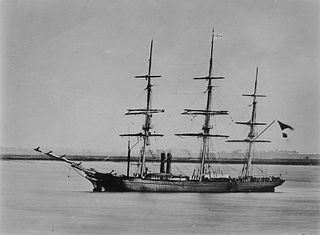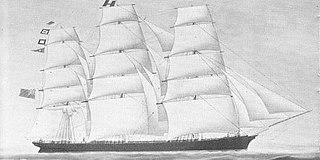
A clipper was a type of mid-19th-century merchant sailing vessel, designed for speed. Clippers were generally narrow for their length, small by later 19th-century standards, could carry limited bulk freight, and had a large total sail area. "Clipper" does not refer to a specific sailplan; clippers may be schooners, brigs, brigantines, etc., as well as full-rigged ships. Clippers were mostly constructed in British and American shipyards, although France, Brazil, the Netherlands, and other nations also produced some. Clippers sailed all over the world, primarily on the trade routes between the United Kingdom and China, in transatlantic trade, and on the New York-to-San Francisco route around Cape Horn during the California Gold Rush. Dutch clippers were built beginning in the 1850s for the tea trade and passenger service to Java.

Cutty Sark is a British clipper ship. Built on the River Leven, Dumbarton, Scotland in 1869 for the Jock Willis Shipping Line, she was one of the last tea clippers to be built and one of the fastest, at the end of a long period of design development for this type of vessel, which ended as steamships took over their routes. She was named after the short shirt of the fictional witch in Robert Burns' poem Tam o' Shanter, first published in 1791.

Thermopylae was an extreme composite clipper ship built in 1868 by Walter Hood & Co of Aberdeen, to the design of Bernard Waymouth of London. Designed for the China tea trade, she set a speed record on her maiden voyage to Melbourne of 63 days, still the fastest trip under sail.

Donald McKay was a Canadian-born American designer and builder of sailing ships, famed for his record-setting extreme clippers.

Leander was a composite built clipper ship. She was designed by Bernard Waymouth, and built in 1867 by J G Lawrie of Glasgow for Joseph Somes. She had a particularly extreme hull shape, with a coefficient of under-deck tonnage of 0.54, a very low figure. She was at her best in light winds and performed well to windward or in a head sea. Being somewhat tender if pressed in heavy weather, she had to carry so much ballast that she was down to her marks before being fully laden.

Sir Lancelot was a clipper ship which sailed in the China trade and the India-Mauritius trade.

Challenger was a wooden clipper ship built in 1852 by Richard & Henry Green, in their Blackwall Yard for Hugh Hamilton Lindsay, London. She was the 291st ship built by the yard and was a remarkable departure from the previous ships produced. In 1850 the American clipper ship Oriental visited West India Docks, the largest clipper ship to visit London and the Admiralty was given permission to take her lines, and this was done by Messrs Waymouth and Cornish, both Lloyd's Surveyors, in the dry dock at Green's Yard in Blackwell. This is probably the reason that it was said that Challenger's design was inspired by and had a close resemblance to the Oriental's.

The Taeping was a tea clipper built in 1863 by Robert Steele & Company of Greenock and owned by Captain Alexander Rodger of Cellardyke, Fife. Over her career, Taeping was the first clipper to dock in London in three different tea seasons. This compares with the highly successful Fiery Cross, who won the "premium" in four separate tea seasons.

In the middle third of the 19th century, the clippers which carried cargoes of tea from China to Britain would compete in informal races to be first ship to dock in London with the new crop of each season. The Great Tea Race of 1866 was keenly followed in the press, with an extremely close finish. Taeping docked 28 minutes before Ariel - after a passage of more than 14,000 miles. Ariel had been ahead when the ships were taken in tow by steam tugs off Deal, but after waiting for the tide at Gravesend the deciding factor was the height of tide at which one could enter the different docks used by each ship. The third finisher, Serica, docked an hour and 15 minutes after Ariel. These three ships had left China on the same tide and arrived at London 99 days later to dock on the same tide. The next to arrive, 28 hours later, was Fiery Cross, followed, the next day, by Taitsing.
The Serica was a clipper built in 1863 by Robert Steele & Co., at Greenock on the south bank of the Clyde, Scotland, for James Findlay. She was the last-but-one wooden clipper built by Steele before the yard went over to building composite clippers.
Flying Spur was a British tea clipper, built of teak and greenheart in 1860.

Lahloo was a British tea clipper known for winning the Tea Race of 1870, and finishing second in the Tea Race of 1871. She sailed from Fuzhou to London with over a million pounds of tea in 1868.

The SS Erl King was built at A and J Inglis, Pointhouse, Glasgow and launched in 1865 and owned by Robertson & Co London. She was designed as an Auxiliary Steam Ship - steam power would be used to supplement the propulsion from the sails, when there was no wind or if there was a light head wind. She was fitted with a propeller that could be lifted up when sailing, so as to reduce drag. The engine was not powerful enough to push the ship, with all the windage of standing rigging, directly into a strong headwind. Auxiliary steam power had the advantage of allowing this vessel to use the Suez Canal when it opened in 1869 - something which was not possible for sailing vessels.

Stornoway was a British tea clipper built by Alexander Hall and Sons in Aberdeen, Scotland in 1850. She was a further development by Hall on the clippers built in Aberdeen in 1848, being larger and more obviously suited to deep sea service. She was ordered by Jardine Matheson specifically for the tea trade. In the late 1840s, tea was available earlier in the season in China, so the first ships to load had to beat to windward against the north-east monsoon to get across the China Sea. The details of the hull shape designed by Hall had this requirement in mind.

John Willis & Sons of London, also called the Jock Willis Shipping Line, was a nineteenth-century London-based ship-owning firm. It owned a number of clippers including the historic tea clipper Cutty Sark.

The Murray was a three-masted clipper ship that was built in Scotland in 1861 and lost off the coast of Sweden in 1884. For nearly 20 years, the Orient Line sailed between London and South Australia. In 1880, Norwegian owners bought her and renamed her Freia.
Kaisow, a composite clipper, was built by Robert Steele & Company at Greenock and launched on 19 November 1868.

Wylo a composite clipper was built by Robert Steele & Company, Greenock, and launched on 15 April 1869. Robert Steele & Company also built the famous clippers Ariel and Taeping who took part in the great tea race of 1866, and Sir Lancelot another renown clipper ship.

In the middle third of the 19th century, the clippers which carried cargoes of tea from China to Britain would compete in informal tea races to be first ship to dock in London with the new crop of each season. These races were also known as the races from China. The consignees of these cargoes wanted to be first in the market with this new crop, so they started to offer a "premium" to a ship that was the first to dock in London in that tea season.















